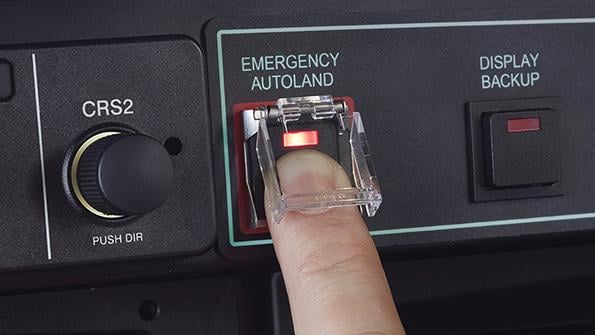
The crew of the 23-year-old Lear 35 radioed air traffic control as they climbed out of Orlando through to a 23,000-ft. altitude and then again to acknowledge their clearance to 39,000 ft. They were never heard from again. The jet continued climbing past its assigned altitude but then failed to turn west toward Dallas, its destination. U.S. Air Force pilots intercepted the silent aircraft, then at 46,000 ft., but got no response when they radioed the pilot. The Lear’s cabin windows were dark and the cockpit windscreens frosted over.
Four hours after takeoff, the Lear began descending—its fuel exhausted. An F-16 pilot watched the jet make several aileron rolls and spiral into the ground near Aberdeen, South Dakota. The Oct. 25, 1999, crash killed all six onboard including pro golfer Payne Stewart. The National Transportation Safety Board determined the accident’s cause was the pilots’ incapacitation “as a result of their failure to receive supplemental oxygen following a loss of cabin pressurization, for undetermined reasons.”
The crash struck a chord with many, including those working at Garmin International in Olathe, Kansas. Phil Straub, then a software engineer, remembers thinking: “Did that really have to happen?” At the time, Gary Burrell, the avionics company’s co--founder (and the “Gar” in its name), was leading an engineering team working on the G1000 digital integrated flight instrumentation system. That, Straub recalls, pointed to an answer.
As additional digital systems were developed and the even more advanced G3000 took form, the idea of a wholly automated landing capability built on its digital foundation took hold. Discussions about the possibility began in the early 2000s, and management readily endorsed the undertaking. “It’s the lifeblood of who we are,” Straub says.
The first software was written and system requirements were initiated in 2011, the same year Straub, a veteran pilot, was appointed head of Garmin’s aviation division. Flight tests began in 2014. In 2015, Straub’s team members alerted the FAA to their goal and engaged various agency offices including flight test, certification and air traffic. After all, their technology fell under the “new and novel” category, and Garmin wanted as much of the regulator’s input as possible. It did the same with the European Union Aviation Safety Agency.
The following February, the software, algorithms and autopilot control loops were deemed ready. And then came the day Chief Test Pilot Tom Carr took his hand off the sidestick controller (but not too far), pushed a button, and watched intently. The Cessna Corvalis he had been piloting turned toward the airport the system deemed most appropriate. It descended from altitude, lined up with the most suitable runway, lowered its flaps, slowed and flared just before touching down. The aircraft squeaked onto the pavement, rolled out on centerline and stopped. The system, christened “Autoland,” worked (AW&ST, Nov. 11-24, 2019, p. 40).
All totaled, Garmin conducted 896 such flights. Piper and Cirrus, the first manufacturers to offer Autoland on the M600 turboprop and SF50 Vision Jet, respectively, have flown hundreds more. In February, Daher announced it is equipping the TBM 940 with Autoland as well. A notable Autoland feature comes into play in extreme circumstances. If the pilot fails to respond to prompts, the system will assume incapacitation and activate automatically—though it can be disengaged with the push of a button.
Straub thought all the ground and flight trials had been completed and necessary boxes checked as of November 2019. He anticipated the FAA certification award for Autoland by year-end. However, much to his frustration, that has not occurred yet; “new and novel,” it seems, can stymie a bureaucracy. But “I think we’re very close,” he adds hopefully.
While pilots are familiar with automation, Autoland serves an additional population: the nonpilots onboard. The new system, Straub says, “gives them an actual say in the outcome of the flight” should something go wrong with the person at the controls.
Others agree. One member of the Malibu M-Class Owners & Pilots Association called Autoland “a game changer.” Another commented: “Even though I never would expect to use it—God forbid something should happen to me while aloft—I will be glad it’s there.” Garmin Autoland is receiving the 2020 Aviation Week Business Aviation Laureate for Safety (AW&ST Jan. 13-26, p. 62).
But Straub suspects that once blessed by FAA and operating in the fleet, Autoland’s first activation is likely to come from an alert pilot spooked by weather or operational demands beyond his or her capability. “And that’s okay,” he says. “It’s better to explain after” than, like Payne Stewart, never have the chance.



Comments